Monthly Updates on Recent Books in the History of Christianity
To raise awareness of recent books in the history of Christianity, the editorial staff of Church History: Studies in Christianity and Culture highlights each month a list of 10-15 books in diverse periods and geographical regions that we hope will be of interest to our members. We include here below the tenth monthly list, chosen by our staff, with excerpts from the publishers’ blurbs.
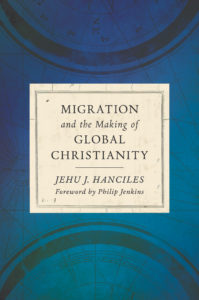
Jehu J. Hanciles, Migration and the Making of Global Christianity. 2021
Human migration has long been identified as a driving force of historical change. Building on this understanding, Jehu Hanciles surveys the history of Christianity’s global expansion from its origins through 1500 CE to show how migration—more than official missionary activity or imperial designs—played a vital role in making Christianity the world’s largest religion.
Church history has tended to place a premium on political power and institutional forms, thus portraying Christianity as a religion disseminated through official representatives of church and state. But, as Hanciles illustrates, this “top-down perspective overlooks the multifarious array of social movements, cultural processes, ordinary experiences, and non-elite activities and decisions that contribute immensely to religious encounter and exchange.”
Hanciles’s socio-historical approach to understanding the growth of Christianity as a world religion disrupts the narrative of Western preeminence, while honoring and making sense of the diversity of religious expression that has characterized the world Christian movement for two millennia. In turning the focus of the story away from powerful empires and heroic missionaries, Migration and the Making of Global Christianity instead tells the more truthful story of how every Christian migrant is a vessel for the spread of the Christian faith in our deeply interconnected world.
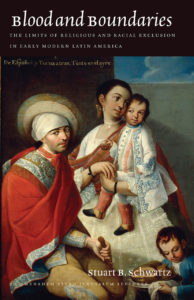
Stuart B. Schwartz, Blood and Boundaries: The Limits of Religious and Racial Exclusion in Early Modern Latin America. 2020
In Blood and Boundaries, Stuart B. Schwartz takes us to late medieval Latin America to show how Spain and Portugal's policies of exclusion and discrimination based on religious origins and genealogy were transferred to their colonies in Latin America. Rather than concentrating on the three principal divisions of colonial society—Indians, Europeans, and people of African origins—as is common in studies of these colonial societies, Schwartz examines the three minority groups of moriscos, conversos, and mestizos. Muslim and Jewish converts and their descendants, he shows, posed a special problem for colonial society: they were feared and distrusted as peoples considered ethnically distinct, but at the same time their conversion to Christianity seemed to violate stable social categories and identities. This led to the creation of "cleanliness of blood" regulations that explicitly discriminated against converts.
Eventually, Schwartz shows, those regulations were extended to control the subject indigenous and enslaved African populations, and over time, applied to the growing numbers of mestizos, peoples of mixed ethnic origins. Despite the efforts of civil and church and state institutions to regulate, denigrate, and exclude, members of these affected groups often found legal and practical means to ignore, circumvent, or challenge the efforts to categorize and exclude them, creating in the process the dynamic societies of Latin America that emerged in the nineteenth century.
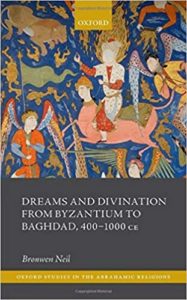
Bronwen Neil, Dreams and Divination from Byzantium to Baghdad, 400-1000 CE. 2021
Why did dreams matter to Jews, Byzantine Christians, and Muslims in the first millennium? Dreams and Divination from Byzantium to Baghdad, 400 - 1000 CE shows how the ability to interpret dreams universally attracted power and influence in the first millennium. In a time when prophetic dreams were viewed as God's intervention in human history, male and female prophets wielded was unparalleled power in imperial courts, military camps, and religious gatherings. The three faiths drew on the ancient Near Eastern tradition of dream key manuals, which offer an insight into the hopes and fears of ordinary people. They melded pagan dream divination with their own scriptural traditions to produce a novel and rich culture of dream interpretation. Prophetic dreams enabled communities to understand their past and present circumstances as divinely ordained and helped to bolster the spiritual authority of dreamers and those who had the gift of interpreting their dreams. Bronwen Neil takes a gendered approach to the analysis of the common culture of dream interpretation across late antique Jewish, Byzantine, and Islamic sources to 1000 CE, in order to expose the ways in which dreams offered women a unique opportunity to exercise influence. The epilogue to the volume reveals why dreams still matter today to many men and women of the monotheist traditions.
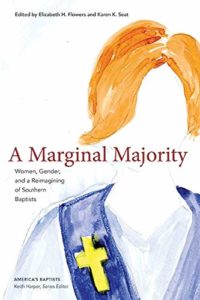
Elizabeth H. Flowers and Karen K. Seat, eds. A Marginal Majority: Women, Gender, and a Reimagining of Southern Baptists. 2020
The University of Tennessee Press
In step with the #MeToo movement and third wave feminism, women’s roles provoke lively debate in today’s evangelical sphere. The Southern Baptist Convention (SBC) has a complicated past regarding this issue, and determining what exactly women’s roles in home, church, and society should be, or even what these roles should be called, has been a contentious subject. In A Marginal Majority: Women, Gender, and a Reimagining of Southern Baptists, editors Elizabeth H. Flowers and Karen K. Seat and eight other contributors examine the SBC’s complex history regarding women and how that history reshapes our understanding of the denomination and its contemporary debates.
This comprehensive volume starts with women as SBC fundraisers, moves to the ways they served Southern Baptist missions, and considers their struggles to find a place at Southern Baptist seminaries as well as their launching of “teaching” or “women’s” ministries. Along the way, it introduces new personalities, offers fresh considerations of familiar figures, and examines the power dynamics of race and class in a denomination that dominated the South and grew into a national behemoth.
Additionally, the essay collection provides insights into why the SBC has often politically aligned with the right. Not only did the denomination become increasingly oriented toward authoritarianism as it clamped down on evangelical feminism, but, as several contributors reveal, even as Southern Baptist women sought agency, they often took it from others. Read together, the chapters strike a somber tone, challenging any triumphal historiography of the past.

Gary Scott Smith, Duty and Destiny: The Life and Faith of Winston Churchill. 2021
What did faith mean to Winston Churchill?
Churchill was far from transparent about his religious beliefs and never regularly attended church services as an adult, even considering himself “not a pillar of the church but a buttress,” in the sense that he supported it “from the outside.” But Gary Scott Smith assembles pieces of Churchill’s life and words to convey the profound sense of duty and destiny, partly inspired by his religious convictions, that undergirded his outlook. Reflecting on becoming prime minister in 1940, he wrote, “It felt as if I were walking with destiny, and that all my past life had been but a preparation for this hour and for this trial.” In a similarly grand fashion, he described opposing the Nazis—and later the Soviets—as a struggle between light and darkness, driven by the duty to preserve “humane, enlightened, Christian society.”
Though Churchill harbored intellectual doubts about Christianity throughout his life, he nevertheless valued it greatly and drew on its resources, especially in the crucible of war. In Duty and Destiny, Smith unpacks Churchill’s paradoxical religious views and carefully analyzes the complexities of his legacy. This thorough examination of Churchill’s religious life provides a new narrative structure to make sense of one of the most important figures of the twentieth century.
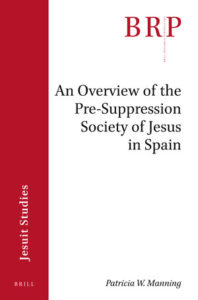
Patricia W. Manning, An Overview of the Pre-suppression Society of Jesus in Spain. 2020
In An Overview of the Pre-Suppression Society of Jesus in Spain, Patricia W. Manning offers a survey of the Society of Jesus in Spain from its origins in Ignatius of Loyola’s early preaching to the aftereffects of its expulsion. Rather than nurture the nascent order, Loyola’s homeland was often ambivalent. His pre-Jesuit freelance sermonizing prompted investigations. The young Society confronted indifference and interference from the Spanish monarchy and outright opposition from other religious orders. This essay outlines the order’s ministerial and pedagogical activities, its relationship with women and with royal institutions, including the Spanish Inquisition, and Spanish members’ roles in theological debates concerning casuistry, free will, and the immaculate conception. It also considers the impact of Jesuits’ non-religious writings.
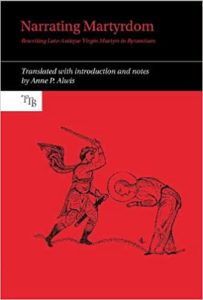
Anne P. Alwis, Narrating Martyrdom: Rewriting Late-Antique Virgin Martyrs in Byzantium. 2020
This book reconceives the rewriting of Byzantine hagiography between the eighth and fourteenth centuries as a skilful initiative in communication and creative freedom, and as a form of authorship. Three men - Makarios (late C13th-C14th), a monk; Constantine Akropolites (d.c.1324), a statesman; and an Anonymous educated wordsmith (c. C9th - each opted to rewrite the martyrdom of a female virgin saint who suffered and died centuries earlier. Their adaptations, respectively, were of St. Ia of Persia (modern-day Iran), St. Horaiozele of Constantinople, and St. Tatiana of Rome. Ia is described as a victim of the persecutions of the Persian Shahanshah, Shapur II (309-79 C.E), Horaiozele was allegedly a disciple of St Andrew and killed anachronistically under the emperor Decius (249-51 C.E), and Tatiana, we are told, was a deaconess, martyred during the reign of emperor Alexander Severus (222-35 C.E). Makarios, Akropolites, and the Anonymous knowingly tailored their compositions to influence an audience and to foster their individual interests.
The implications arising from these studies are far-reaching: this monograph considers the agency of the hagiographer, the instrumental use of the authorial persona and its impact on the audience, and hagiography as a layered discourse. The book also provides the first translations and commentaries of the martyrdoms of these virgin martyrs.
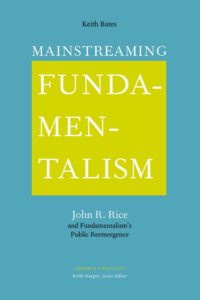
Keith Bates. Mainstreaming Fundamentalism: John R. Rice and Fundamentalism’s Public Reemergence. 2021
The University of Tennessee Press
In Mainstreaming Fundamentalism: John R. Rice and Fundamentalism’s Public Reemergence, Keith Bates embarks on a thematic and chronological exploration of twentieth-century Baptist fundamentalism in postwar America, sharing the story of a man whose career intersected with many other leading fundamentalists of the twentieth century, such as J. Frank Norris, Bob Jones Sr., Bob Jones Jr., and Jerry Falwell.
Unique among histories of American fundamentalism, this book explores the theme of Southern fundamentalism’s reemergence through a biographical lens. John R. Rice’s mission to inspire a broad cultural activism within fundamentalism—particularly by opposing those who fostered an isolationist climate—would give direction and impetus to the movement for the rest of the twentieth century. To support this claim, Bates presents chapters on Rice’s background and education, personal and ecclesiastical separatism, and fundamentalism and political action, tracing his rise to leadership during a critical phase of fundamentalism’s development until his death in 1980.
Bates draws heavily upon primary source texts that include writings from Rice’s fundamentalist contemporaries, his own The Sword of the Lord articles, and his private papers—particularly correspondence with many nationally known preachers, local pastors, and laypeople over more than fifty years of Rice’s ministry. The incorporation of these writings, combined with Bates’s own conversations with Rice’s family, facilitate a deeply detailed, engaging examination that fills a significant gap in fundamentalist history studies.
Mainstreaming Fundamentalism: John R. Rice and Fundamentalism’s Public Reemergence provides a nuanced and insightful study that will serve as a helpful resource to scholars and students of postwar American fundamentalism, Southern fundamentalism, and Rice’s contemporaries.
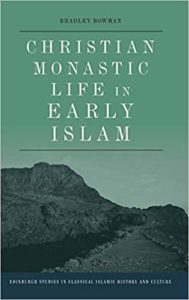
Bradley Bowman. Christian Monastic Life in Early Islam. 2021
During the rise of Islam, Muslim fascination with Christian monastic life was articulated through a fluid, piety-centered movement. Bradley Bowman explores this confessional synthesis between like-minded religious groups in the medieval Near East. He argues that this potential ecumenism would have been based upon the sharing of core tenets concerning piety and righteous behavior. Such fundamental attributes, long associated with monasticism in the East, likely served as a mutually inclusive common ground for Muslim and Christian communities of the period. This manifested itself in Muslim appreciation, interest and - at times - participation in Christian monastic life.
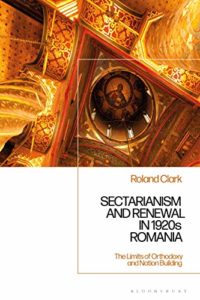
Roland Clark, Sectarianism and Renewal in 1920s Romania: The Limits of Orthodoxy and Nation-Building. 2020
The Romanian Orthodox Church expanded significantly after the First World War, yet Protestant Repenter and schismatic Orthodox movements such as Old Calendarism also grew exponentially during this period, terrifying church leaders who responded by sending missionary priests into the villages to combat sectarianism. Several lay renewal movements such as the Lord's Army and the Stork's Nest also appeared within the Orthodox Church, implicating large numbers of peasants and workers in tight-knit religious communities operating at the margins of Eastern Orthodoxy.
Bringing the history of the Orthodox Church into dialogue with sectarianism, heresy, grassroots religious organization and nation-building, Roland Clark explores how competing religious groups in interwar Romania responded to and emerged out of similar catalysts, including rising literacy rates, new religious practices and a newly empowered laity inspired by universal male suffrage and a growing civil society who took control of community organizing. He also analyses how Orthodox leaders used nationalism to attack sectarians as 'un-Romanian', whilst these groups remained indifferent to the claims the nation made on their souls.
Situated at the intersection of transnational history, religious history and the history of reading, Sectarianism and Renewal in 1920s Romania challenges us to rethink the one-sided narratives about modernity and religious conflict in interwar Eastern Europe.
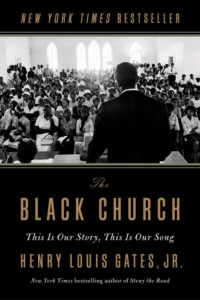
Henry Louis Gates, Jr., The Black Church: This Is Our Story, This Is Our Song. 2021
For the young Henry Louis Gates, Jr., growing up in a small, residentially segregated West Virginia town, the church was a center of gravity—an intimate place where voices rose up in song and neighbors gathered to celebrate life's blessings and offer comfort amid its trials and tribulations. In this tender and expansive reckoning with the meaning of the Black Church in America, Gates takes us on a journey spanning more than five centuries, from the intersection of Christianity and the transatlantic slave trade to today’s political landscape. At road’s end, and after Gates’s distinctive meditation on the churches of his childhood, we emerge with a new understanding of the importance of African American religion to the larger national narrative—as a center of resistance to slavery and white supremacy, as a magnet for political mobilization, as an incubator of musical and oratorical talent that would transform the culture, and as a crucible for working through the Black community’s most critical personal and social issues.
In a country that has historically afforded its citizens from the African diaspora tragically few safe spaces, the Black Church has always been more than a sanctuary. This fact was never lost on white supremacists: from the earliest days of slavery, when enslaved people were allowed to worship at all, their meetinghouses were subject to surveillance and destruction. Long after slavery’s formal eradication, church burnings and bombings by anti-Black racists continued, a hallmark of the violent effort to suppress the African American struggle for equality. The past often isn’t even past—Dylann Roof committed his slaughter in the Mother Emanuel AME Church 193 years after it was first burned down by white citizens of Charleston, South Carolina, following a thwarted slave rebellion.
But as Gates brilliantly shows, the Black church has never been only one thing. Its story lies at the heart of the Black political struggle, and it has produced many of the Black community’s most notable leaders. At the same time, some churches and denominations have eschewed political engagement and exemplified practices of exclusion and intolerance that have caused polarization and pain. Those tensions remain today, as a rising generation demands freedom and dignity for all within and beyond their communities, regardless of race, sex, or gender. Still, as a source of faith and refuge, spiritual sustenance and struggle against society’s darkest forces, the Black Church has been central, as this enthralling history makes vividly clear.

Madeleine Pennington, Quakers, Christ, and the Enlightenment. 2021
The Quakers were by far the most successful of the radical religious groups to emerge from the turbulence of the mid-seventeenth century--and their survival into the present day was largely facilitated by the transformation of the movement during its first fifty years. What began as a loose network of charismatic travelling preachers was, by the start of the eighteenth century, a well-organised and international religious machine. This shift is usually explained in terms of a desire to avoid persecution, but Quakers, Christ, and the Enlightenment argues instead for the importance of theological factors as the major impetus for change.
In the first sustained account of the theological changes guiding the development of seventeenth-century Quakerism, Madeleine Pennington explores the Quakers' positive intellectual ngagement with those outside the movement to offer a significant reassessment of the causal factors determining the development of early Quakerism. Considering the Quakers' engagement with such luminaries as Baruch Spinoza, Henry More, John Locke, and John Norris, Pennington unveils the Quakers' concerted attempts to bolster their theological reputation through the refinement of their central belief in the 'inward Christ', or 'the Light within'. In doing so, she further challenges stereotypes of early modern radicalism as anti-intellectual and ill-educated. Rather, the theological concerns of the Quakers and their interlocutors point to a crisis of Christology weaving through the intellectual milieu of the seventeenth century, which has long been under-estimated as significant fuel for the emerging Enlightenment.
Finally, for staying up-to-date on the latest titles in all fields, we recommend regularly perusing New Books Network and its "New Books in Christian Studies” page. These pages are updated regularly.
